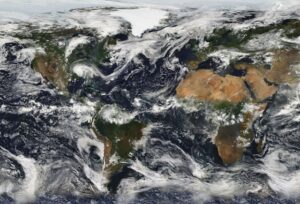Physical Address
23,24,25 & 26, 2nd Floor, Software Technology Park India, Opp: Garware Stadium,MIDC, Chikalthana, Aurangabad, Maharashtra – 431001 India
Physical Address
23,24,25 & 26, 2nd Floor, Software Technology Park India, Opp: Garware Stadium,MIDC, Chikalthana, Aurangabad, Maharashtra – 431001 India

A viral post by Steve Milloy @JunkScience on X claims that emissions did not cause the 2023-2024 warming spike, attributing it solely to a natural super El Niño, and asserts that climate models failed to predict this event. He further argues that heat waves do not correlate with greenhouse gas emissions, downplaying the role of human activities in driving extreme heat and global warming.
X Post:
Claim 1: Emissions didn’t cause the warming spike of 2023-2024; models missed the event.
Fact: Misleading. The warming spike of 2023-2024 was indeed influenced by a strong El Niño, a natural climate phenomenon that temporarily raises global temperatures. However, attributing this event solely to natural causes overlooks the critical role of human-induced climate change. El Niño events occur against the backdrop of a warming planet, and the baseline temperatures today are significantly higher due to decades of greenhouse gas emissions.
Climate models are designed to predict long-term trends rather than specific, short-term natural fluctuations like El Niño. While the timing and intensity of the 2023-2024 warming spike may not have been fully anticipated, the models have consistently shown that global temperatures will continue to rise as emissions increase. This event underscores how natural variability can exacerbate the impacts of human-induced climate change rather than disprove it.
Claim 2: The warming spike was caused by the natural super El Niño that ended in 2024, enhanced by other natural factors.
Fact: Partial. It is true that the 2023-2024 super El Niño played a significant role in the warming spike. El Niño events are known to redistribute heat from the ocean to the atmosphere, temporarily elevating global temperatures. However, the intensity of recent El Niño events has been amplified by the persistent warming trend caused by human activity. This long-term warming provides a “higher starting point,” making natural climate variations more extreme.
Other natural factors, such as volcanic activity or changes in solar radiation, have played a minimal role compared to the overwhelming impact of greenhouse gases. The interaction between natural events like El Niño and anthropogenic warming highlights the compounding effects of climate change, where even natural phenomena become more pronounced due to human activity.
Claim 3: Heat waves do not correlate with emissions.
Fact: False. Scientific evidence unequivocally shows that greenhouse gas emissions are directly linked to increased heat wave frequency, duration, and intensity. As the atmosphere warms due to emissions, it holds more heat and moisture, creating conditions conducive to extreme heat events. Studies have found that every significant heat wave in recent years has been significantly more severe due to human-induced climate change.
Furthermore, attribution studies provide a clear picture of this relationship. For instance, the record-breaking heat waves in 2023 were found to be at least 10 times more likely due to emissions. Ignoring this connection misrepresents the scientific consensus and undermines efforts to address the root causes of climate change.
The Role of El Niño in a Warming World
El Niño is a natural climate phenomenon characterised by the warming of surface waters in the equatorial Pacific Ocean, which leads to significant shifts in global weather patterns. Historically, these events have been associated with temporary spikes in global temperatures, changes in precipitation patterns, and extreme weather events such as droughts, floods, and hurricanes. While El Niño is natural, its effects are now playing out in a world where human activities have significantly warmed. The result amplifies the phenomenon’s impacts, making them more intense and far-reaching than in the past. For instance, the 2023-2024 El Niño contributed to record-breaking global temperatures. However, these records were not solely a product of the event itself—they were superimposed on a baseline of elevated temperatures caused by decades of greenhouse gas emissions.
The interaction between El Niño and anthropogenic climate change is a prime example of how natural variability and human-induced factors can combine to create more severe outcomes. Claims that emissions did not play a role in the warming spike of 2023-2024 are misleading because they ignore the foundational warming trend caused by greenhouse gases. While El Niño temporarily exacerbates global temperatures, the truth is that its impacts are now magnified in a warmer atmosphere created by human activity. Recognising the dual role of natural and human influences debunks such myths and underscores the urgency of addressing emissions to mitigate the compounded effects of climate change.
References:
https://wmo.int/news/media-centre/2024-track-be-hottest-year-record-warming-temporarily-hits-15degc
https://science.nasa.gov/earth/explore/el-nino
Banner image:
Comments are closed.
Awesome site you have here but I was curious about if you knew of any message boards that cover the same topics discussed in this article? I’d really like to be a part of community where I can get advice from other knowledgeable individuals that share the same interest. If you have any suggestions, please let me know. Many thanks!